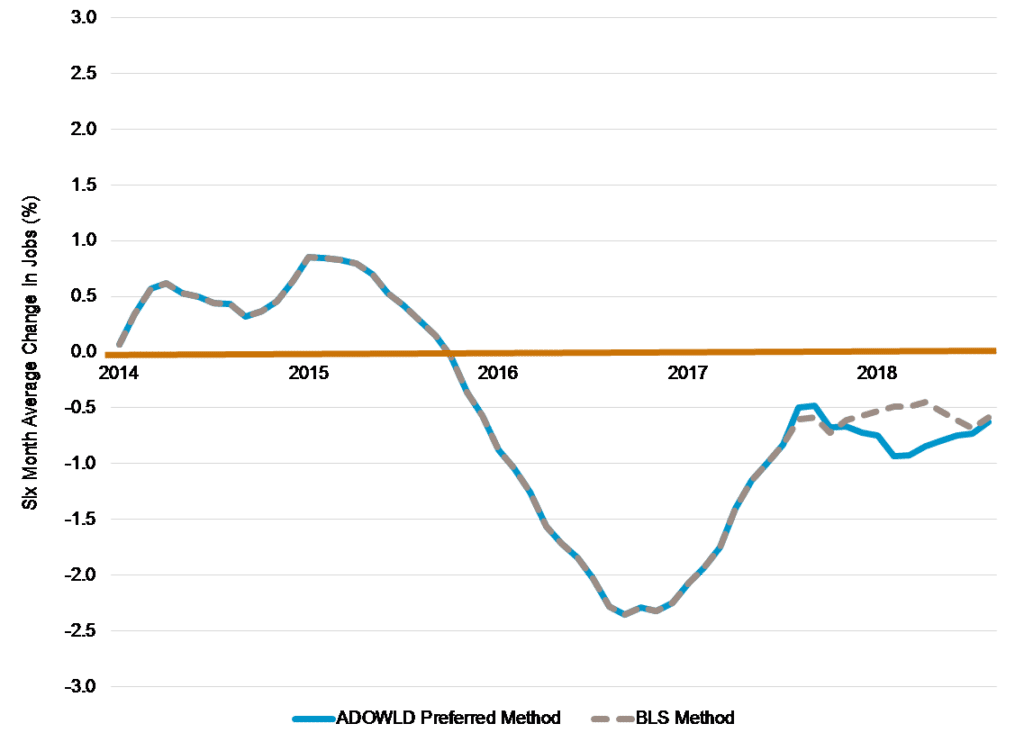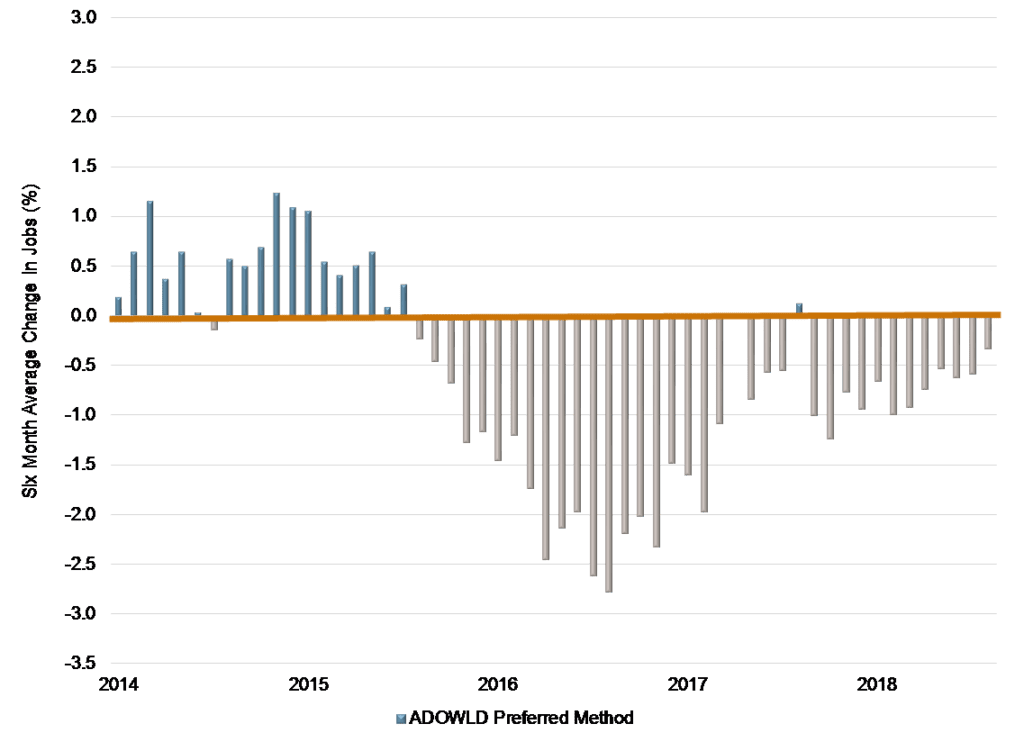
My gut, and the data, are sending very mixed feelings about 2019. First, let’s acknowledge that my Growth-Recession Indicator (GRI) still has Alaska firmly in an employment recession. The GRI currently indicates for the six months prior to October 2018 (the last month for which data are available) that the state’s economy was losing jobs at a rate -0.6 percent. Much better than the -2.4 percent rate the GRI hit in late 2016, but still not close to the -0.2 percent to 0.2 percent rate which is where, a year ago, I thought we would be now. The economy’s recovery stalled out right at the end of 2017 and its stayed in this stubborn band losing between -0.5 and -1.0 percent of jobs compared to the year before.
Figure 1. Halcyon Consulting Growth-Recession Indicator (Rolling Six YOY Average)
I see some signs for optimism in the monthly Year-Over-Year trend (see Figure 2); October 2018 employment was just -0.3 lower than October 2017 employment and the longer trend of smaller percentage monthly losses coming out of the depth of the recession is still intact. However, I am troubled by what was a stronger middle of 2017 (see the area in the figure with fewer gray columns and one little blue pip) which was then followed by a weaker end to 2017. Something happened at the end of 2017 which derailed a 2018 recovery. Looking back at the monthly data, there was one “final” round of oil sector cuts in October/November 2017 which removed 400-600 jobs from the economy and that’s right when the track to recovery stalled out. Coincidence? I don’t know, but essentially in 2018 we experienced a recession within a recession, but the last couple of months look “better” or perhaps “less worse”.
Figure 2. Year-Over-Year Monthly Employment Changes
Other facts that make me feel optimistic:
- In three of the last four quarters both private sector and “All Industry” gross state product has been higher than the year before. That’s the best string of data since the first three quarter of 2015. In short, the value of our economy is now increasing and not decreasing.
- Alaskan’s per capita income has increased for six consecutive quarters and total nonfarm wages are up for four consecutive quarters. There are fewer of us working, but we’re making more individually and in aggregate than we did last year and the year before.
- The number of sole proprietors in Alaska (i.e, non-wage and salary business owners) is at an all time high with a reported 97,467 proprietors at the end of 2017. That figure is 3,500 more than in 2015. As the recession took hold, people started businesses at a rate not seen since 2006.
- I don’t hear business owners talking about cutting. What I hear them talking about is asking the question “Do I need to replace this position?” when a position becomes available and “Where do I find qualified help?”. They certainly aren’t in a hiring mode, but not laying off is a good start.
Things which give me real pause for 2019:
- ANS oil prices have gone from $63 a barrel at this time last year to $80 a barrel in late June, back down to below $60 as a I write this sentence. Another round of oil sector retrenchment will extend the recession.
- The Dunleavy Administration has promised big spending cuts. A gross rule of thumb is that every $1 million in cuts on Alaska-based personnel costs the economy 10 jobs in the public sector and another 5 in the private sector. There is no magical line between public and private sector economies; in the end it’s one big circulatory system and we’re all living in it. Triple dip anyone?
- The world economy is slowing which could mean less tourism and lower resource prices across the board.
- I don’t see any significant external stimuli for 2019 that will juice the state economy. In fact, I think the risks for the economy are higher in 2019 than they were in 2018.
Jonathan’s Takeaway: The takeaway for 2019 is simple- It’s going to be an interesting year. Hang on. In the remainder of this space let me publicly thank the personnel of the Anchorage School System for their amazing performance during and following the November 30th earthquake. I was at my son’s school during the earthquake and the admin, teachers, and students handled the situation like professionals. There was no panic, the immediate communication at school was clear, precise, and caring, and the district’s follow-up communications were spot on. We entrust you with our children and on November 30th you proved you deserve that trust. May it always be so.
Jonathan King is a consulting economist and Certified Professional Coach. His firm, Halcyon Consulting, is dedicated to helping clients reach their goals through accountability, integrity, and personal growth. Jonathan has 21 years of social science consulting experience including 15 years in Alaska. The comments in this blog do not necessarily represent the view of employers and clients past or present and are Jonathan’s alone. Suggested blog topics, constructive feedback, and comments are desired at askjonathan@apcm.net.
12/19/18








